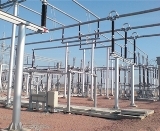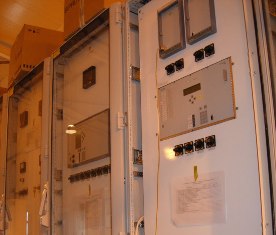Power restoration in 110 kV bus differential protection operation
 Differential protection of busbars (DZSh) is designed to protect the busbar systems of the substation switchgear from short circuits in the coverage area of this protection. The area of operation of the DZSh is limited by current transformers that are included in its circuit.
Differential protection of busbars (DZSh) is designed to protect the busbar systems of the substation switchgear from short circuits in the coverage area of this protection. The area of operation of the DZSh is limited by current transformers that are included in its circuit.
Normally current transformers are connected to DZS scheme, are installed behind the outgoing connection circuit breakers (to the line), which ensures that not only the busbar systems and bus disconnectors are included in the coverage area of this protection, but also the outgoing connection circuit breakers, including their busbars to the bus disconnectors .
Tire differential protection is triggered when faults occur in the coverage area, if the fault is on one of the output lines, that is, outside the coverage area, then the protection will not work.
Let's look at several cases of bus tripping at a 110 kV substation when the bus differential protection tripped, and the actions of service personnel to restore power in each situation.
The output connections of the switchgear can operate in two modes when triggering the DZSh. When one of the bus systems shuts down, the power supply is restored (tested) through the connection whose operating mode is set to "automatic bus reclose". Each of the bus systems has its own connection that carries the voltage in the event of a power failure. The rest of the connections work in the "Automotive assembly" mode — they are released automatically in case of successful supply of voltage to the bus system.
Let's consider several cases of disconnection of 110 kV bus systems during operation of DZSH-110kV, that is, when auto-closing of buses fails or does not work for one reason or another.
If a fault occurs in one of the 110 kV busbar systems and it is disconnected, the power transformer also loses its power which is fixed behind the given busbar system. Therefore, the first thing to do is to make sure that the automatic switch of the connecting bus (section) switches of the systems (sections) of the secondary voltage of the transformers (35/10 kV) is working. If for one reason or another the ATS does not work, it must be duplicated, that is, manually power the disabled sections of the substation.
Next, you need to check the disabled bus system.If the inspection reveals damage to the busbar system, then it is necessary to take it out for repair, having previously fixed all connections of this busbar system to an undamaged 110 kV busbar system, including the switched-off supply transformer. The normal mode circuit is then restored from the 35/10 kV sides. Power supply to the disabled bus system is restored only after the damage has been removed.
It is also possible to damage equipment that is in the zone of differential protection of the busbars, namely: circuit breakers of outgoing connections and their buses from bus disconnectors to current transformers connected to the DZSH circuit. In this case, it is necessary to disconnect the damaged element from the circuit by disconnecting the bus and the disconnector of the line of this connection.
After that, the disabled bus system can be put into operation. That is, the voltage is applied to the bus system, and upon successful acceptance of the voltage, all links are put into operation, except for the link on which the equipment is damaged.
When supplying voltage to a vented transformer, as in the previous case, the normal mode circuit of 35 / 10kV bus sections (systems), which are normally supplied by this transformer, is restored. Damaged equipment, which is excluded from the scheme, is taken out for repair in order to determine the cause of the damage and its further elimination.
If, when the voltage in the 110 kV bus system disappears, the 110 kV consumers turn off, then exceptionally it is necessary to duplicate the operation of the DZSh automation — turn on the 110 kV line, which performs the automatic reclosing of this bus system. In case of successful acceptance of the voltage from the busbar system, turn on the remaining vented connections that were disconnected from the busbar differential protection. Repeated automatic shutdown of the compartment switch when attempting to energize a busbar system indicates a fault in that busbar system.
It is also possible to disable both bus systems through the action of the DZSh protection. In general, the cause of a total blackout of the bus is a failure of the bus breaker. In this case, it is necessary to make sure that the reason for the operation of the DZSh is a defective SHSV, then it is necessary to disconnect it from the circuit by disconnecting it from both sides with bus disconnectors.
In addition, the scheme of the normal mode of the substation is restored and earthing operations are carried out on the disconnected SHSV for the production of repair and restoration works.
The reason for the operation of the DZSh and the disappearance of the voltage on one of the bus systems of the 110 kV substation may be a false operation of the protection. The main reasons for the false activation of this protection:
- discrepancy between the position of the connection fixing key and the actual position of its bus disconnectors;
- software error in the operation of the protective device made on the microprocessor terminal;
- other technical malfunctions in the DZSh set;
- personnel operational errors when production of operating keys.
In this case, you need to make sure that the protection operation is really false. After that, it is necessary to restore the normal circuit, eliminating the cause of the false alarm. If the cause of the false activation is a software error or a technical malfunction of an element of the protective kit, before restoring the circuit, it is necessary to turn off the DZSh and take measures for further troubleshooting in accordance with the present instructions.
It should be noted that the management of the emergency response process is entrusted to the senior operative - the duty dispatcher. The operation of protections and automation, as well as all performed operations, are recorded by the staff on duty in the operational documentation.
In the absence of communication with the dispatcher or in the event of a threat to people's lives and the condition of the equipment, the operating personnel of the electrical installation performs operations to eliminate the accident on its own with the subsequent notification to the dispatcher about the operations performed. Therefore, for the service personnel who maintain an electrical installation, the main task is to know and have practical skills to eliminate substation accidents, in particular actions when the substation bus systems are disconnected as a result of bus differential protection.

